Caryn’s Thoughts
 The desert is known to be a wide expanse of sand, and not much else of any value, but that doesn’t mean that there is no vegetation there. Usually you will find shrubs and patches of weeds here and there as well as the occasional cactus. There aren’t usually many trees, but there usually are a few. L’Arbre du Ténéré, known in English as the Tree of Ténéré, was a solitary Acacia tree that was once considered the most isolated tree on Earth. In fact, it was the only tree for over 250 miles.
The desert is known to be a wide expanse of sand, and not much else of any value, but that doesn’t mean that there is no vegetation there. Usually you will find shrubs and patches of weeds here and there as well as the occasional cactus. There aren’t usually many trees, but there usually are a few. L’Arbre du Ténéré, known in English as the Tree of Ténéré, was a solitary Acacia tree that was once considered the most isolated tree on Earth. In fact, it was the only tree for over 250 miles.
The tree was located in the Sahara Desert. At one time the tree had been part of a lush and populated forest, but as time went on, the trees began to die out, until L’Arbre du Ténéré stood alone in a barren desert as an isolated landmark for caravan routes through the Ténéré region of the Sahara in northeast Niger for hundreds of years. Anyone who traveled the desert knew about the tree. That tree and the Arbre Perdu or ‘Lost Tree’ to the north are so well known, that they are the only trees to be shown on a map at a scale of 1:4,000,000.
Against all odds, the tree survived hundreds of years of desertification. It was one tough tree. Then one day in  1973, a drunk truck driver managed to hit the only obstacle in 250 miles…the L’Arbre du Ténéré tree. How could someone…even a drunk driver manage to hit a tree, with miles of open desert all around it? It boggles the mind.
1973, a drunk truck driver managed to hit the only obstacle in 250 miles…the L’Arbre du Ténéré tree. How could someone…even a drunk driver manage to hit a tree, with miles of open desert all around it? It boggles the mind.
The Tenere region was not always a desert. As sun seasons change things all over the Earth, it went from sea floor to rainforest to desert over the centuries. Still, through it all one little tree stood strong. Finally, the Ténéré region became inhospitable with little vegetation and an average annual rainfall of only 2.5 centimeters. After a time, water was even scarce underground. By the early 20th century, all that remained was a small group of the thorned, yellow-flowered Acacias of the Ténéré. Finally, all but one died, leaving it as the only surviving tree in a 250 mile radius…which made its destruction even more tragic. After the tree was struck down, the dead tree was moved to the Niger National Museum. That is all that remains of the once great forest of Acacia trees in that region.
 On December 21, 1988, at 7:00pm, Pan Am Flight 103 from London to New York exploded in midair over Lockerbie, Scotland, killing all 243 passengers and 16 crew members aboard, as well as 11 Lockerbie residents on the ground. A bomb hidden inside an audio cassette player detonated in the cargo area when the plane was at an altitude of 31,000 feet. The disaster, which became the subject of Britain’s largest criminal investigation, was believed to be an attack against the United States, because although the passengers came from 21 countries, the majority, 189 of the 259 victims on the plane were American. Islamic terrorists were accused of planting the bomb on the plane while it was at the airport in Frankfurt, Germany. The investigation lasted for years, 15,000 people were interviewed and 180,000 pieces of evidence were examined. Finally, in 2001, Mohmed al-Megrahi was convicted and sentenced to 20…and later 27 years in prison. Lamin Khalifa Fhimah was acquitted, and the Libyan government eventually agreed to pay damages to the families of the victims.
On December 21, 1988, at 7:00pm, Pan Am Flight 103 from London to New York exploded in midair over Lockerbie, Scotland, killing all 243 passengers and 16 crew members aboard, as well as 11 Lockerbie residents on the ground. A bomb hidden inside an audio cassette player detonated in the cargo area when the plane was at an altitude of 31,000 feet. The disaster, which became the subject of Britain’s largest criminal investigation, was believed to be an attack against the United States, because although the passengers came from 21 countries, the majority, 189 of the 259 victims on the plane were American. Islamic terrorists were accused of planting the bomb on the plane while it was at the airport in Frankfurt, Germany. The investigation lasted for years, 15,000 people were interviewed and 180,000 pieces of evidence were examined. Finally, in 2001, Mohmed al-Megrahi was convicted and sentenced to 20…and later 27 years in prison. Lamin Khalifa Fhimah was acquitted, and the Libyan government eventually agreed to pay damages to the families of the victims.
The lateness of the explosion made much of the recovery impossible until the stark light of day, when the horror really became clear to the world. The reasons for the attack, in the minds of Islamic terrorists were to destroy life as much as possible, and I’m sure they thought they had succeeded. Yes, the people who died and their family, will never get over their loss. It just doesn’t work that way. It never goes away, but out of that tragedy, came something amazing too…the Lockerbie Heroes.
Lockerbie is a small town in Scotland, and something like this attack is unheard of. Such things seemed so far  away, but as we all know, such things can come to small towns, and it is then that these little hamlets take center stage…sometimes for a short time, sometimes for years, and sometimes its forever. This small town took it upon themselves, to make a difference. Most of us would run away from the horror, or hide so we didn’t have to face it, but not the citizens of Lockerbie. Every member of this town turned out, and with no specific plan in place, they simply started to help. On that December day in 1988, a Pan Am flight had blown up, and hundreds of pieces of metal, random, objects, and body parts come raining out of the sky.
away, but as we all know, such things can come to small towns, and it is then that these little hamlets take center stage…sometimes for a short time, sometimes for years, and sometimes its forever. This small town took it upon themselves, to make a difference. Most of us would run away from the horror, or hide so we didn’t have to face it, but not the citizens of Lockerbie. Every member of this town turned out, and with no specific plan in place, they simply started to help. On that December day in 1988, a Pan Am flight had blown up, and hundreds of pieces of metal, random, objects, and body parts come raining out of the sky.
Most of us assume that we would go into state of panic, but the people of Lockerbie didn’t have time to panic. They were too busy diving into the wreckage to collect any personal items they might find. No, not to keep them or sell them on eBay, it was the 80’s after all. They did it simply to comfort the victim’s families. In order to store the tens of thousands of debris pieces that had been scattered over 845 square miles, the first thing the townspeople did was build a warehouse. Any items that weren’t of forensic value were left for the townspeople to organize. These The compassionate people of Lockerbie knew that they couldn’t hand them to the bereaved families looking so ugly. The reality was that seeing these items in the condition they were now, would be pure torture. The townspeople decided to perform an act of love and compassion. Working as a gigantic assembly line of washers and dryers and ironers and folders, the townspeople restored the countless items of clothing scattered across the charred, muddy, usually quite apocalyptic landscape. They developed rolls and film and put diaries back together to identify the owners, while any stray rings, wallets, and other effects were carefully matched up to the corresponding suitcase. In one instance, the State Department informed one family that they couldn’t have their daughter’s stuff back because it was “too badly damaged.” The people of Lockerbie scoffed at that and un-damaged it. What a gift. You can’t help but cry and the enormity  of their kindness.
of their kindness.
Before long, the relatives flocked to Lockerbie in order to be near to the site of the crash. The town opened its doors and took them in, setting the foundation for friendships that still survive today. Christmas cards are exchanged, letters are written, and families still journey to the town. It takes a lot of awesome to turn a town from “giant crater where my loved one died” to “place of friendship and comfort.” As the years have passed, the people coming aren’t as many, but the town of Lockerbie and the world remember each and every victim.

 My grand niece, Izabella Harman is a sweet little girl, with great big eyes. She is sweet natured, and yet sassy, which I love. She reminds me of me…in the sassy things anyway. I always hope I’m sweet natured, but that isn’t my call. Izabella, on the other hand is definitely sweet natured. She has a smile that will light up her whole face, and people can’t help but love her. Her parents are definitely going to have to fight off the boys with Izabella and her sister Alice, who is a lot like her little sister.
My grand niece, Izabella Harman is a sweet little girl, with great big eyes. She is sweet natured, and yet sassy, which I love. She reminds me of me…in the sassy things anyway. I always hope I’m sweet natured, but that isn’t my call. Izabella, on the other hand is definitely sweet natured. She has a smile that will light up her whole face, and people can’t help but love her. Her parents are definitely going to have to fight off the boys with Izabella and her sister Alice, who is a lot like her little sister.
I love watching Alice, Izabelle, and their brother, Jaxx when they play. They genuinely like each other, not just love each other. These three bring so much joy to their parents, Melanie  and Jake Harman. Watching them run around the house playing and giggling would put a smile on anyone’s face. These kids are all happy and healthy, and full of energy, so when they get going, it’s no holds barred. And little brother Jaxx, has no trouble keeping up with his sisters.
and Jake Harman. Watching them run around the house playing and giggling would put a smile on anyone’s face. These kids are all happy and healthy, and full of energy, so when they get going, it’s no holds barred. And little brother Jaxx, has no trouble keeping up with his sisters.
Izabella is a little shy around people she doesn’t know well, but that isn’t a bad thing. Once she gets to know you, she is quite talkative, and her cute little voice is fun. I remember when she first started talking. Her little teeny voice and those big eyes were totally charming. I can’t believe she is 4 years old already. Where has the time gone? Before we know it these kids will be all grown up and married. That’s how it feels with their daddy. It seems like just yesterday he and his little sister were babies. Now they have their own babies. Slow down Belle. Today is Izabella’s 4th birthday. Happy birthday Belle!! Have a great day!! We love you!!
 My nephew, Isaac Spethman has always been an innovative young man, wanting to work from a young age, which we were all proud of, but also found to be really cute thing for a little boy to want to do. Isaac hasn’t changed much over the years, other than his size of course. He is still in the process of shaping up to be an excellent young man, and one who makes us all proud.
My nephew, Isaac Spethman has always been an innovative young man, wanting to work from a young age, which we were all proud of, but also found to be really cute thing for a little boy to want to do. Isaac hasn’t changed much over the years, other than his size of course. He is still in the process of shaping up to be an excellent young man, and one who makes us all proud.
Isaac isn’t perfect, of course, what boy is, or girl for that matter. He plays rough with his siblings, Xander, Zack, and Aleesia, and fights with them too, picks on his little sister, Aleesia. Kids can be enough to drive their parents crazy sometimes, but they  are also a very rewarding part of life. I don’t know one parent who would trade one minute of fighting for peace and quiet.
are also a very rewarding part of life. I don’t know one parent who would trade one minute of fighting for peace and quiet.
Isaac started wrestling this year and seems to excel at it too. He won his first match. Not bad for a new wrestler, but then he does have brothers and I know they do a lot of wrestling, although probably not the legal kind. Isaac is quick, and seems to be able to break out of a hold pretty easily. I know he will have a very successful year, and while I wont be at the  matches, I’ll cheer him on from home. Have a great year Isaac.
matches, I’ll cheer him on from home. Have a great year Isaac.
Recently Isaac has been asked to be an usher at church. It is a job he takes very seriously, and he does an excellent job. I think he is the youngest usher we have, and the people of the church are very pleased with him too. Isaac is and always has been a boy who takes responsibility very seriously. He remembers what he is supposed to do, and does it exactly as he is supposed too. He is meticulous about it. That is very unusual in a young boy, but then Isaac isn’t your average young boy. And he is shaping up to be a great young man. Today is Isaac’s 13th birthday. Happy birthday Isaac!! Have a great day!! We love you!!
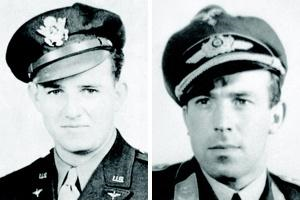 In a war, the point is to kill the enemy, or be killed by the enemy. There is no room for soft hearts and compassion…or is there? On December 20, 1943, Charlie Brown, an American B-17 bomber pilot and his crew attempted to bomb an aircraft production facility in Bremen, Germany, as part of a bombing run with a squadron of B-17s. Unfortunately, the interior areas of Germany were better fortified with anti-aircraft guns. As the bombing run reached the factory, and dropped the payload, the 250 anti-aircraft guns which surrounded the factory were fired. Charlie Brown’s B-17, Ye Olde Pub, was hit, disabling two engines and forcing the plane out of formation. It was the habit of the German fighter planes to go after any stragglers, knowing that they were the weaker link. Brown’s damaged B-17 was chased down and several of the crew members were seriously wounded. The hit also knocked out all but one of the plane’s engines.
In a war, the point is to kill the enemy, or be killed by the enemy. There is no room for soft hearts and compassion…or is there? On December 20, 1943, Charlie Brown, an American B-17 bomber pilot and his crew attempted to bomb an aircraft production facility in Bremen, Germany, as part of a bombing run with a squadron of B-17s. Unfortunately, the interior areas of Germany were better fortified with anti-aircraft guns. As the bombing run reached the factory, and dropped the payload, the 250 anti-aircraft guns which surrounded the factory were fired. Charlie Brown’s B-17, Ye Olde Pub, was hit, disabling two engines and forcing the plane out of formation. It was the habit of the German fighter planes to go after any stragglers, knowing that they were the weaker link. Brown’s damaged B-17 was chased down and several of the crew members were seriously wounded. The hit also knocked out all but one of the plane’s engines.
Thinking the plane was doomed, the fighters turned their attention to other prey. Meanwhile, Ye Olde Pub tried to limp along toward England, hoping not to be spotted. Of course, they knew their hope of escape was quite unlikely, and before long they were spotted by German fighter pilot Franz Stigler, who was refueling. Stigler jumped into his plane and took off, catching up with the wounded plane quickly. Stigler was about to blast the plane, when he saw that the crew was seriously wounded. Stigler, a combat veteran with 22 confirmed kills, was reluctant to attack a defenseless aircraft, so instead pulled alongside the B-17 cockpit and signaled the crew to land. They refused. He then motioned in the direction of Sweden, which would get them on the ground, but also take them out of the war. It didn’t really matter, because the Allied crew didn’t understand.
Unable to convince them to land, but also unwilling to leave them, Stigler flew side-by-side with the stricken bomber, even though he was afraid his own plane might identify him, and his actions might get him executed. As Brown’s B-17 approached the safety of the English Channel, Stigler saluted and peeled off…not really expecting the B-17 to make it safely home. Miraculously, Brown kept the plane in the air and made it to England. Brown  often wondered why Stigler hadn’t shot him down, but never expected to know who the unknow German fighter pilot was. Nevertheless, after the war, Brown placed an ad in a World War II newsletter for pilot veterans. Amazingly, Stigler, who had relocated to Canada, saw the ad. The two pilots reunited, both still in shock to see the other, and when Brown ask the question that had been burning in his mind for years…why didn’t Stigler shoot them down? Stigler explained that to shoot at them would have been dishonorable. Charlie Brown was shocked to know that even among the enemy, there could exist such compassion. The two pilots immediately felt like they were forever connected. They remained close friends until their deaths in 2008.
often wondered why Stigler hadn’t shot him down, but never expected to know who the unknow German fighter pilot was. Nevertheless, after the war, Brown placed an ad in a World War II newsletter for pilot veterans. Amazingly, Stigler, who had relocated to Canada, saw the ad. The two pilots reunited, both still in shock to see the other, and when Brown ask the question that had been burning in his mind for years…why didn’t Stigler shoot them down? Stigler explained that to shoot at them would have been dishonorable. Charlie Brown was shocked to know that even among the enemy, there could exist such compassion. The two pilots immediately felt like they were forever connected. They remained close friends until their deaths in 2008.
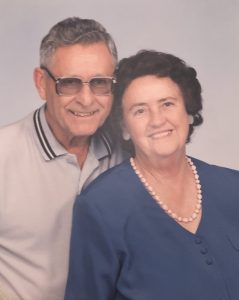 My uncle, George Hushman entered life in a troubled situation, and in the end, it was destined to get worse. His mother passed away when he was very young, and his dad was not involved or interested in his children’s lives or welfare. Uncle George and his sister, Betty were placed in an orphanage. They would not be one of the few older children to get adopted, because as most of us know, adoptive parents prefer babies. That might seem like the end of a sad story, but it isn’t. While George was not adopted “officially,” he did have families who “adopted” him in many ways. Wallace and Hettie Saint John, who were my future son-in-law, Kevin Petersen’s great grandparents, were very good to Uncle George, who was friends with their sons. The treated him like one of the family.
My uncle, George Hushman entered life in a troubled situation, and in the end, it was destined to get worse. His mother passed away when he was very young, and his dad was not involved or interested in his children’s lives or welfare. Uncle George and his sister, Betty were placed in an orphanage. They would not be one of the few older children to get adopted, because as most of us know, adoptive parents prefer babies. That might seem like the end of a sad story, but it isn’t. While George was not adopted “officially,” he did have families who “adopted” him in many ways. Wallace and Hettie Saint John, who were my future son-in-law, Kevin Petersen’s great grandparents, were very good to Uncle George, who was friends with their sons. The treated him like one of the family.
Then, of course, there was the Byer family, into which Uncle George would marry, 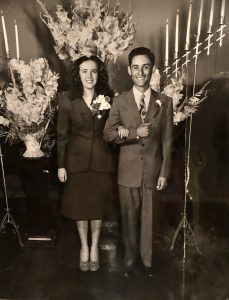 making him my Uncle George when he married my aunt, Evelyn Byer. This was the point when Uncle Georges life took its most amazing turn. Upon their meeting, my aunt and uncle only had eyes for each other. Their world was suddenly filled with all of God’s greatest blessings. Their marriage would produce five beautiful children, Sheila “Susie” Young, George Byer, Shelley Campbell, Shannon Limmer, and Greg Hushman. They also went on to have many grandchildren, great grandchildren, and great great grandchildren. Theirs was a match made in Heaven. They were happy, and they were together as much as it was possible. Their marriage would endure the hardships and sadness that every marriage does, and it thrived. Anyone who knew them could see their great happiness. At the time of Aunt Evelyn’s passing on May 4, 2015, they had been married for 68 years. That is almost unheard of!! When Uncle George joined her in Heaven, they had been married 71 years, and they were
making him my Uncle George when he married my aunt, Evelyn Byer. This was the point when Uncle Georges life took its most amazing turn. Upon their meeting, my aunt and uncle only had eyes for each other. Their world was suddenly filled with all of God’s greatest blessings. Their marriage would produce five beautiful children, Sheila “Susie” Young, George Byer, Shelley Campbell, Shannon Limmer, and Greg Hushman. They also went on to have many grandchildren, great grandchildren, and great great grandchildren. Theirs was a match made in Heaven. They were happy, and they were together as much as it was possible. Their marriage would endure the hardships and sadness that every marriage does, and it thrived. Anyone who knew them could see their great happiness. At the time of Aunt Evelyn’s passing on May 4, 2015, they had been married for 68 years. That is almost unheard of!! When Uncle George joined her in Heaven, they had been married 71 years, and they were 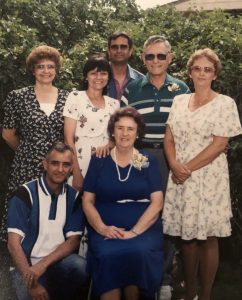 reunited on Uncle George’s 92nd birthday. What a wonderful birthday present. Their eyes got to see each other once more, their hearts were reunited. I’m sure Uncle George was ecstatic!!
reunited on Uncle George’s 92nd birthday. What a wonderful birthday present. Their eyes got to see each other once more, their hearts were reunited. I’m sure Uncle George was ecstatic!!
Uncle George was a quiet sort of man, but always kind. I always loved going over to their home, because we were always treated kindly by them both. They had built their house in Mills, Wyoming, in 1948, with the help of family. They loved their home, and unlike most couples, they would live in that same home for the rest of their lives. Most couples look around some before settling on their forever home. Others moves several times before really finding one that suits them. Not Aunt Evelyn and Uncle George. The knew what they wanted, and they never waivered. Theirs was a sweet forever home, where the couple that lived there were forever in love. Happy birthday in Heaven Uncle George. We love and miss you very much.

 Throughout their childhood, my nieces, Michelle Stevens and Lindsay Moore were the best of friends. They were always having adventures…usually funny ones. The girls at one time decided that they needed a secret language, so that they could communicate all their little girl secrets privately. Of course, in reality they were talking gibberish, but the language sounded close enough to legitimate, that it might have fooled the untrained ear. The girls loved to talk their secret language…especially in public. They actually got pretty good at it, and might have even understood each other, as can happen in these developed childhood languages.
Throughout their childhood, my nieces, Michelle Stevens and Lindsay Moore were the best of friends. They were always having adventures…usually funny ones. The girls at one time decided that they needed a secret language, so that they could communicate all their little girl secrets privately. Of course, in reality they were talking gibberish, but the language sounded close enough to legitimate, that it might have fooled the untrained ear. The girls loved to talk their secret language…especially in public. They actually got pretty good at it, and might have even understood each other, as can happen in these developed childhood languages.
Michelle’s imagination was quite good. She likes to tease people in pure “Michelle” fashion, by telling people she was on her way to their house, when she was actually at home. She even went so far as to say she was outside their house, and could see them through their window…when in reality, she never really intended to come over at all. She was quite funny, and I think maybe her imagination soon led to her chosen career…art.
After Michelle graduated from Black Hills State University, with a teaching degree and an art degree, she moved back to Casper, Wyoming, hoping to get a job in the local school district. With the country in a downturn, schools were closing, and jobs weren’t available. So, Michelle found another type of dream job. The Nicolaysen Art Museum snatched her right up for a teaching position there. Michelle loves working with the various groups, teaching art projects and classes with people of all ages. Veterans, home schoolers, art club, seniors. This is a different kind of teaching than she thought she would be doing, in that the students are of all ages. That is an unexpected pleasure for Michelle, who didn’t expect to be working with adults, when she went into teaching. She absolutely loves it.
For an artist, the art museum is a favorite place to be, and she love the Nicolaysen, and takes great pride in it, as well as working there. Recently, Michelle was chosen to do an Art Integration Conference for teachers Professional Development. It was a great honor. She was a presenter for one of the sessions, at which time gave a lecture about Art Basics for the Non-Artistic. Hmmm…I should have attended that one, since Michelle has more artistic ability in one strand of hair, that I have in my whole body. Her lecture was a quick breakdown of Introduction to Art, after which she gave the teachers various strategies on ways to integrate art into any class. The people at the museum are super impressed with her and have put their faith in her. Her boss, Zhanna wants her to help her develop a whole Art integration Conference for 2021. We are very proud of her.
Time changes things, and for Michelle, that means that with the improving economy, the Natrona County School District is once again looking at her for teaching positions. She will start substitute teaching in the 
 school district in January, and she is hoping to land one of the three art teacher positions opening in the school in June. Of course, that would mean leaving the Nicolaysen…a move that saddens both Michelle and her work family at the Nicolaysen. She has not finalized her plans in that respect, but it is an opportunity that will be impossible to pass up. We all wish her well, in whatever decision she makes. Today is Michelle’s birthday. Happy birthday Michelle!! Have a great day!! We love you!!
school district in January, and she is hoping to land one of the three art teacher positions opening in the school in June. Of course, that would mean leaving the Nicolaysen…a move that saddens both Michelle and her work family at the Nicolaysen. She has not finalized her plans in that respect, but it is an opportunity that will be impossible to pass up. We all wish her well, in whatever decision she makes. Today is Michelle’s birthday. Happy birthday Michelle!! Have a great day!! We love you!!
 War is a serious matter, but that does not mean that mistakes can’t be made that are really funny when you think about them. After the War of 1812, the United States government was understandably concerned about British ships having access to US borders. The decision was made to built a fort on the border of New York and Canada. It was a good plan that, in the end, had just one flaw.
War is a serious matter, but that does not mean that mistakes can’t be made that are really funny when you think about them. After the War of 1812, the United States government was understandably concerned about British ships having access to US borders. The decision was made to built a fort on the border of New York and Canada. It was a good plan that, in the end, had just one flaw.
This plan might have brought into existence, the first American fort, had it not been for one minor detail. The fort was intended to be called Fort Montgomery, and was to be located at the northern end of Lake Champlain. That was all well and good, but there is a moral to the story. “Before you build, make sure your surveyors know what they’re doing.” Construction was begun on the first fort at this location, an octagonal structure with 30 foot high walls, in 1816 to protect against an attack from British Canada such as that which led to the Battle of Plattsburgh in 1814. In July 1817, President James Monroe visited the incomplete fortification and the adjacent military reservation known locally as “the commons.”
This might have been a triumphant visit, however, due to an earlier surveying error it was later found that this first fort was inadvertently built on the Canadian side of the border, resulting in its sometimes being better known as “Fort Blunder.” Of course, that was not its real name, and in fact the fort was never officially named. I suppose the reality is that the United States didn’t have the right to name the fort, because it wasn’t on US land. Nevertheless, the fort was named…unofficially. It became Fort Blunder, because that is exactly what it was. A colossal blunder!!
No one realized the problem with the fort at first. Two years and $275,000 after construction of the fort began, surveyors discovered a problem: The fort was being built on the wrong side of the border. Joseph Totten, later chief engineer of the US Army, supervised construction of the octagonal, 30 foot tall structure. It was to have 125 cannons, and any British ship sailing past would come under heavy fire. Under the Treaty of Paris, the 45th parallel marked the border between New York and Quebec. Therefore, the fort designed to protect the United States from Canada was in…Canada!! All work stopped on the fort, and the heretofore unnamed citadel earned the nickname Fort Blunder.
For the next 20 years, the abandoned fort was subjected to looting. The stones from the fort were taken away  to be used for homes, shops, and meetinghouses. In the end, the United States fixed the location problem not by moving the fort, but by moving the boundary line. In the 1920s, the United States sold Fort Montgomery at auction. In 1983, Victor Podd, a Montreal shipping magnate, bought it. He offered part of the property to New York State for a historic site, but New York didn’t want it. I guess it wouldn’t make sense to make a historical site out of a mistake. After Podd died in 1999, his sons inherited Fort Montgomery. They tried to sell it on eBay and actually got a bid for $5 million, but the deal fell through. The owners still want to sell Fort Montgomery. You can buy it for less than $1 million.
to be used for homes, shops, and meetinghouses. In the end, the United States fixed the location problem not by moving the fort, but by moving the boundary line. In the 1920s, the United States sold Fort Montgomery at auction. In 1983, Victor Podd, a Montreal shipping magnate, bought it. He offered part of the property to New York State for a historic site, but New York didn’t want it. I guess it wouldn’t make sense to make a historical site out of a mistake. After Podd died in 1999, his sons inherited Fort Montgomery. They tried to sell it on eBay and actually got a bid for $5 million, but the deal fell through. The owners still want to sell Fort Montgomery. You can buy it for less than $1 million.
 After the Japanese attacked Pearl Harbor, the people of the United States were justifiably nervous about the Japanese American citizens. Many of these people had family in Japan, and their loyalty was in question. No one felt safe, so on February 19, 1942, just 10 weeks later, President Franklin D Roosevelt signed Executive Order 9066, authorizing the removal of any or all people from military areas “as deemed necessary or desirable.”
After the Japanese attacked Pearl Harbor, the people of the United States were justifiably nervous about the Japanese American citizens. Many of these people had family in Japan, and their loyalty was in question. No one felt safe, so on February 19, 1942, just 10 weeks later, President Franklin D Roosevelt signed Executive Order 9066, authorizing the removal of any or all people from military areas “as deemed necessary or desirable.”
The feeling of panic that had been simmering since the attack wasn’t going away when it came to the Japanese, or the Japanese Americans, so the military defined the entire West Coast, home to the majority of Americans of Japanese ancestry or citizenship, as a military area. What began as a plan to protect the military areas, quickly escalated, and by June, more than 110,000 Japanese Americans were relocated to remote internment camps built by the United States military in scattered locations around the 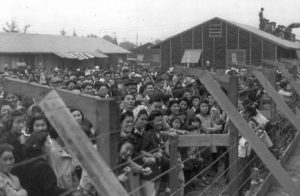 country, where they would remain for the next two and a half years. Many of these Japanese Americans endured extremely difficult living conditions and poor treatment by their military guards. It wasn’t what we would expect of our own military, but it was a tense time. It almost seemed like “guilt by association” or in this case, by race. They were Japanese, and that made people wary of them…and no one was in the mood to listen to their side.
country, where they would remain for the next two and a half years. Many of these Japanese Americans endured extremely difficult living conditions and poor treatment by their military guards. It wasn’t what we would expect of our own military, but it was a tense time. It almost seemed like “guilt by association” or in this case, by race. They were Japanese, and that made people wary of them…and no one was in the mood to listen to their side.
The internment of these loyal Japanese Americans was, at the very least, unfair, and at worst, just short of criminal. It was only short of criminal because it was approved by the President of the United States. Finally, after two and a half years, United States Major General Henry C Pratt issued Public Proclamation No. 21, declaring that, effective January 2, 1945, Japanese American “evacuees” from the West Coast could return to their homes. The nightmare was over. Of 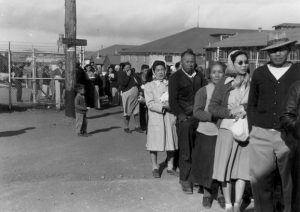 course, being over doesn’t mean that everything went immediately back to the way it was before. These people had to find new jobs and homes, because their jobs, and possibly their homes, were no longer there for them to return to.
course, being over doesn’t mean that everything went immediately back to the way it was before. These people had to find new jobs and homes, because their jobs, and possibly their homes, were no longer there for them to return to.
During the course of World War II, ten Americans were convicted of spying for Japan, but not one of them was of Japanese ancestry, which is disgusting…not that no Japanese Americans were part of that, but that any American would betray their country in this way. In 1988, President Ronald Reagan signed a bill to recompense each surviving internee with a tax-free check for $20,000 and an apology from the United States government.
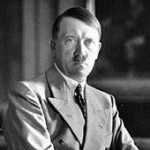
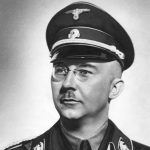 During his reign, Hitler was determined to rid the world of those people he decided were of an inferior race…basically anyone who was not blonde haired, blue-eyed, and fair skinned. It was a seriously strange idea considering that Hitler had dark hair, and it is rumored that Hitler may have had both Jewish and African ancestry. I don’t suppose he would have liked knowing that much, or maybe he knew and didn’t care.
During his reign, Hitler was determined to rid the world of those people he decided were of an inferior race…basically anyone who was not blonde haired, blue-eyed, and fair skinned. It was a seriously strange idea considering that Hitler had dark hair, and it is rumored that Hitler may have had both Jewish and African ancestry. I don’t suppose he would have liked knowing that much, or maybe he knew and didn’t care.
Hitler had a plan in mind to create the “perfect” race. His plan was two-fold. Most people know about the Holocaust, and the mass killing of Jews, Gypsies, and other “undesirable” races, by starvation, beatings, and most notably, the gas chambers. It is not known exactly how many people were killed, but the number is estimated at 6 million Jews, and as many as 11 million other groups. It was horrific, but it was not the only plan Hitler had.
His other plan was the Lebensborn, which translates as “wellspring of life” or “fountain or life.” The Lebensborn project was one in which women…who were of the Aryan race, a historical race concept which emerged in the period of the late 19th century and mid-20th century to describe people of Indo-European heritage as a racial grouping. Heinrich Himmler founded the Lebensborn project on December 12, 1935, the same year the Nuremberg Laws outlawed intermarriage with Jews and others who were deemed inferior. In the beginning, the Lebensborn children were taken to SS nurseries. But in order to create a “super-race,” the SS transformed these nurseries into “meeting places” for “racially pure” German women who wanted to meet and have children with SS officers. The idea was that they were doing something great for “the cause.” The children born in the Lebensborn nurseries were then taken by the SS. The Lebensborn provided support for expectant mothers, we or unwed, by providing a home and the means to have their children in safety and comfort. For decades, Germany’s birthrate had been decreasing, and Himmler’s goal was to reverse the decline and increase the Germanic/Nordic population of Germany to 120 million. Himmler encouraged SS and Wermacht officers to have children with Aryan women. He believed Lebensborn children would grow up to lead a Nazi-Aryan nation. Once the children were born, the woman had the choice to marry the SS officer father, or give the child up for adoption. She was not allowed to keep the child on her own, and once she entered the Lebensborn she could not leave until the child was delivered.
Any children who were born with any defects were immediately put to death. The program had no room for any special-needs children. The children who were given up by the mothers, were usually kept at the Lebensborn for about a year before they were made available for adoption, and then only to SS or Wermacht soldiers families or members of the Nazi party. During their time in the SS nursery, they were named by Himmler. The whole purpose of this society (Registered Society Lebensborn – Lebensborn Eingetragener Verein) was to offer to young girls who were deemed “racially pure” the possibility to give birth to a child in secret. The child was then given to the SS organization which took charge in the child’s education and adoption. Both mother and father needed to pass a “racial purity” test. Blond hair and blue eyes were preferred, and family lineage had to be traced back at least three generations. Of all the women who applied, only 40 percent passed the racial purity test and were granted admission to the Lebensborn program. The majority of mothers were unmarried, 57.6 percent until 1939, and about 70 percent by 1940.
One of the most horrible sides of the Lebensborn policy was the kidnapping of children “racially good” in the eastern occupied countries after 1939. Some of these children were orphans, but it is well documented that many were stolen from their parents’ arms. These kidnappings were organized by the SS in order to take children by force who matched the Nazis’ racial criteria…blond hair and blue or green eyes. Thousands of children were taken to the Lebensborn centers in order to be “Germanized.” Up to 100,000 children may have 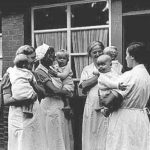
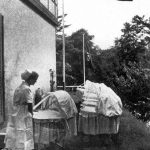 been stolen from Poland alone. In these centers, everything was done to force the children to reject and forget their birth parents. The SS nurses were told to persuade the children that they were deliberately abandoned by their parents. The children who refused the Nazi education were often beaten. Most of those who rejected Nazi principles were transferred to concentration camps, usually in Kalish in Poland, and exterminated. The others were adopted by SS families. The whole Lebensborn program was twisted. It was like growing machines who would believe and do as they were told, which is what they thought the children would grow up to do.
been stolen from Poland alone. In these centers, everything was done to force the children to reject and forget their birth parents. The SS nurses were told to persuade the children that they were deliberately abandoned by their parents. The children who refused the Nazi education were often beaten. Most of those who rejected Nazi principles were transferred to concentration camps, usually in Kalish in Poland, and exterminated. The others were adopted by SS families. The whole Lebensborn program was twisted. It was like growing machines who would believe and do as they were told, which is what they thought the children would grow up to do.

